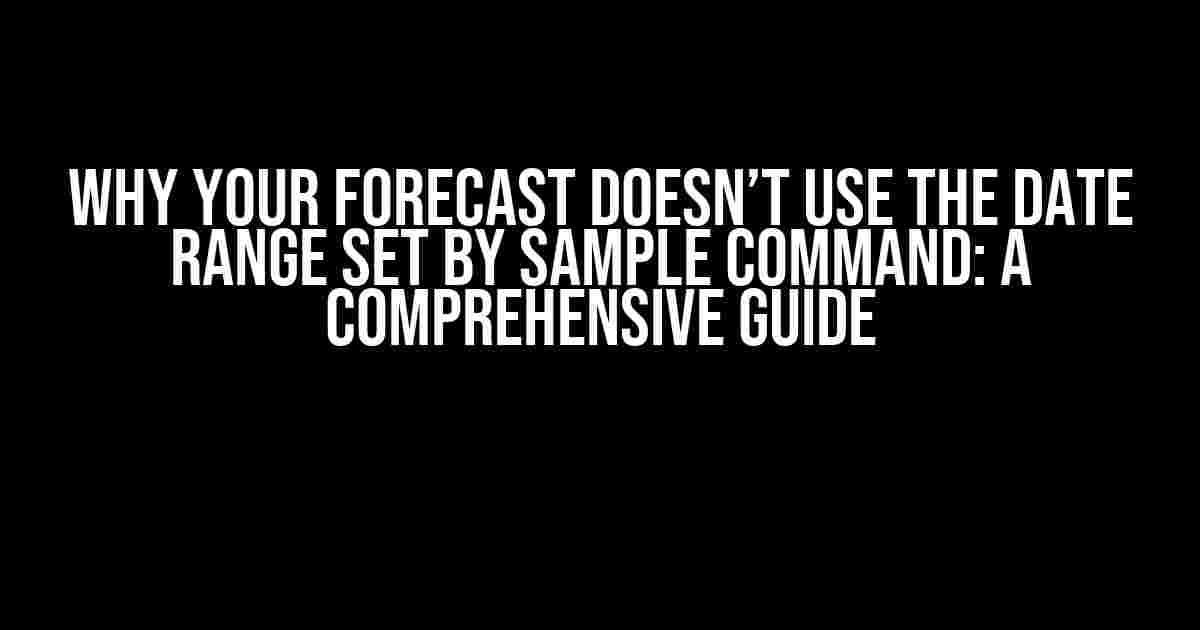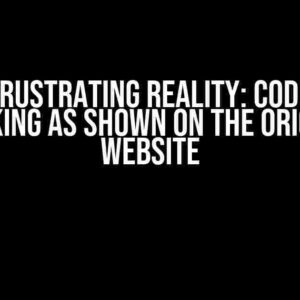Are you frustrated because your forecast isn’t using the date range set by the sample command? You’re not alone! This is a common issue many data analysts and forecasting enthusiasts face. But fear not, dear reader, for we’re about to dive into the world of forecasting and date ranges, and by the end of this article, you’ll be a pro at setting up your forecasts to use the correct date range.
What is the Sample Command?
The sample command is a powerful tool used in forecasting to specify a subset of data to be used for training a model. It allows you to define a specific date range for which you want to create a forecast. Sounds simple, right? But, as we all know, sometimes things don’t go as planned.
Why Doesn’t My Forecast Use the Date Range Set by Sample Command?
There are several reasons why your forecast might not be using the date range set by the sample command. Let’s go through some of the most common culprits:
- Incorrect syntax**: Make sure you’re using the correct syntax for the sample command. A small mistake can lead to a big headache.
- Date format issues**: Ensure that the date format in your data matches the date format specified in the sample command. This is a common gotcha!
- Missing or incorrect date column**: Double-check that you have a date column in your data and that it’s correctly formatted.
- Conflicting commands**: Be aware of other commands that might be overriding the sample command. We’ll cover this in more detail later.
Setting Up Your Forecast to Use the Correct Date Range
Now that we’ve discussed the possible reasons why your forecast isn’t using the correct date range, let’s dive into the step-by-step process of setting up your forecast to use the correct date range:
- Verify your data**: Ensure that your data is clean, complete, and in the correct format.
- Define your date column**: Identify the date column in your data and make sure it’s correctly formatted.
- Specify the date range**: Use the sample command to specify the date range you want to use for your forecast. For example:
sample start_date = '2020-01-01' end_date = '2020-12-31' - Check for conflicting commands**: Review your code for any conflicting commands that might be overriding the sample command. We’ll cover this in more detail later.
- Run your forecast**: With the correct date range specified, run your forecast and enjoy the fruits of your labor!
Common Pitfalls to Avoid
When working with forecasting and date ranges, there are a few common pitfalls to avoid:
- Using the wrong date format**: Make sure you’re using the correct date format in your sample command. This can lead to confusion and incorrect results.
- Failing to account for daylight saving time (DST): If your data spans across DST changes, ensure you’re accounting for this in your date range.
- Not considering holidays and weekends**: If your forecast is affected by holidays and weekends, make sure you’re excluding these dates from your sample range.
Conflicting Commands: The Silent Forecast Killers
When working with forecasting, it’s easy to get caught up in the excitement of creating complex models and forget about the potential conflicts between different commands. Let’s take a closer look at some common conflicting commands that might be overriding your sample command:
| Command | Description | Conflict Risk |
|---|---|---|
train |
Specifies the training data for the model. | High |
test |
Specifies the testing data for the model. | Medium |
eval |
Specifies the evaluation data for the model. | Low |
As you can see, the train command is a high-risk conflict candidate, as it can override the sample command and affect the date range used for your forecast. Be sure to review your code carefully and prioritize the sample command when necessary.
Conclusion
In conclusion, getting your forecast to use the correct date range set by the sample command is a crucial step in creating accurate and reliable forecasts. By following the steps outlined in this article, you’ll be well on your way to mastering the art of forecasting with date ranges.
Remember to:
- Verify your data and date column.
- Specify the correct date range using the sample command.
- Check for conflicting commands.
- Run your forecast with confidence!
With these tips and tricks, you’ll be forecasting like a pro in no time. Happy forecasting!
Frequently Asked Question
Don’t get left in the dark! Find answers to your forecast questions here.
Why does my forecast not use the date range set by the sample command?
Check if you’ve correctly set the date range in your sample command. The forecast feature only uses the date range specified in the sample command if it’s in the correct format. Double-check your syntax and try again!
Is there a specific format for the date range in the sample command?
Yes! The date range should be in the format ‘YYYY-MM-DD HH:MM:SS’ to ‘YYYY-MM-DD HH:MM:SS’. Make sure to use the correct format to avoid any issues. For example, ‘2022-01-01 00:00:00’ to ‘2022-01-31 23:59:59’.
What if I want to forecast for a specific period, but the sample command doesn’t allow it?
In that case, you can use the ‘forecastdaterange’ command to specify the exact date range for your forecast. This command overrides the date range set in the sample command, giving you more control over your forecast.
Can I use the forecastdaterange command with other forecasting commands?
Yes, you can use the forecastdaterange command with other forecasting commands, such as ‘forecast’ or ‘forecastfull’. This allows you to customize your forecast to your specific needs.
What happens if I don’t specify a date range in the sample command or forecastdaterange command?
If you don’t specify a date range, the forecasting feature will use the default date range set in your system. This default date range may not be what you intended, so it’s always best to specify a date range to ensure accurate results.


